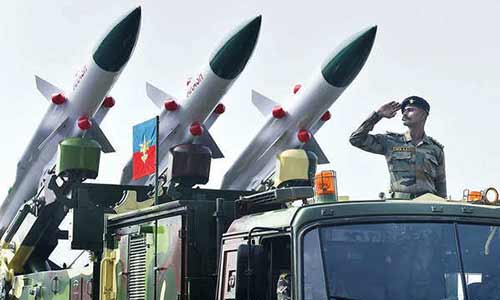Front-loading India’s clarion call for self-reliance – known as the “Atmanirbhar Bharat (Self-Reliant India)” initiative – New Delhi has announced new defence procurement measures that put a phased embargo on the import of 101 items of defence equipment.
The sudden announcement, that came over a weekend, could not only be a game changer for indigenous manufacturing, but also a great opportunity for Indian defence manufacturers to develop their capabilities and technologies, experts say.
Putting equipment under the import embargo forces the country’s army to buy these items from local manufacturers rather than taking the easy way out and buying imports.
“This decision will offer great opportunity to the Indian defence industry to manufacture items on the negative list by using its own design and development capabilities or adopting the technologies designed and developed by the Defence R&D Organisation to meet the requirements of the Armed Forces,” the Defence Minister Rajnath Singh tweeted on Sunday.
The list, according to the minister, was prepared after several rounds of consultations with all stakeholders, including the Armed Forces, public and private industry, to assess current and future capabilities of Indian industry to manufacture various ammunition and equipment within the country.
The embargo on imports has been planned to be progressively implemented between 2020 and 2024, so that the Indian defence industry can ramp up in a phased manner, anticipate requirements of the Armed Forces, and be better prepared to realise the goal of indigenisation, the minister added.
For instance, starting from December, the military will rely exclusively on indigenous vendors for 69 categories of defence equipment, including self-propelled and towed artillery guns, multi-barrelled rocket launchers, bulletproof jackets and helmets, several types of warships, light transport aircraft, light combat fighter aircraft, light combat helicopters, and ground transport vehicles.
‘Orders worth $50+ billion over 6-7 years’
“Almost 260 schemes of such items were contracted by the Tri-Services [army, navy and air force] at an approximate cost of Rs 3.5 lakh crore [$47 billion] between April 2015 and August 2020. It is estimated that contracts worth almost Rs 4 lakh crore [$53 billion] will be placed upon the domestic industry within the next six to seven years,” the minister tweeted.
“Militaries all over the world generally follow the thumb rule of 30-40-30, which means that 30% of the fleet should be equipment with latest technology. 40% of the fleet could be five to eight years old, while the last 30% could be 8 to 15 years old,” Lavina Quadros, a defence analyst with Jefferies, an equity research firm, told Asia Times Financial.
“Most of the items embargoed fall in the 40%, and the 30% categories, which clearly means that local manufacturers have had sufficient time to adopt the technology and acquire the capability of manufacturing those items indigenously,” she added. “Basically, India still has the option of importing 30% of its requirement with cutting-edge technology.”
With its annual imports worth $100 billion of defence equipment, India is already one of the world’s top importers, and a very lucrative market.
Read More: Draft defence production policy makes defence sector ‘Atmanirbhar’
Atmanirbhar Bharat yet a dream, no strategy devised
India traditionally buys military equipment from Russia, but is increasingly purchasing from the United States and Israel, according to Reuters. Between April 2015 and August 2020, India’s defence services had contracted around Rs 3.5 trillion worth of items that are now on the hold list.
“[The Sunday’s] policy announcement has been a positive surprise for the industry, since for the first time, India has articulated specific guidelines and mentioned a clear timeline,” a research report by the Mumbai-based investment research firm Edelweiss said.
Over the last four months, India announced a series of reforms in the defence sector to provide clarity on the procurement strategy. These include, a separate budget for domestic capital procurement, stopping phased import of equipment or sourcing the spares locally, that say industry sources, take the local procurement of parts and equipment above 40% per cent.
“What is noteworthy here is a clear timeline and specific item-wise imports embargo to help the manufacturers, especially the private sector, prepare better and commit more investments across the value chain,” the Edelweiss report said. “These developments are a step in the right direction given the inclusive approach and better clarity.”
However, according to Manoj Joshi, a defence analyst with the Observer Research Foundation, a New Delhi-based think tank, said just putting out a list alone won’t do the trick.
“There are many bureaucratic loopholes still around, that is why the Defence Procurement Policy keeps on getting revised with astonishing regularity,” he said.
Meanwhile, the defence minister said on Monday that the list of embargoed imported defence equipment would be expanded, as it would save millions in imports.
























